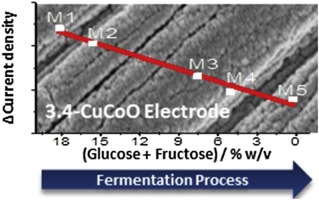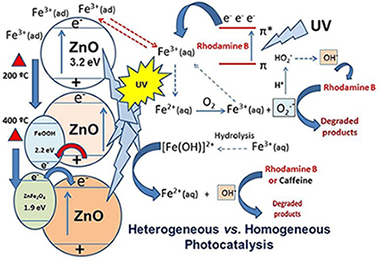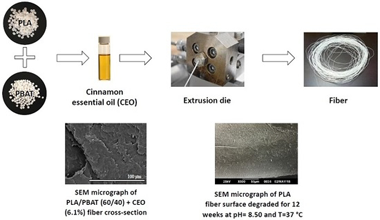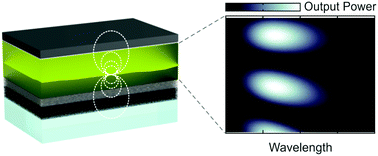Artículos SCI
2020
2020
Nanotecnología en Superficies y Plasma
Robust label-free CuxCoyOz electrochemical sensors for hexose detection during fermentation process monitoring
Lopez-Fernandez, E; Gil-Rostra, J; Espinos, JP; Gonzalez, R; Yubero, F; de Lucas-Consuegra, A; Gonzalez-Elipe, ARSensors and Actuators B-Chemical, 304 (2020) 127360
Show abstract ▽

Label free electrochemical sensors of glucose are used whenever long-term operation and stable response are required. For this purpose, various metals and oxides of the first transition series have been proposed as alternative to more expensive noble metal electrochemical sensors. In this work we propose a new formulation consisting of copper-cobalt mixed oxides which, in the form of porous and nanostructured thin films with well controlled Co/Cu ratio, are prepared at room temperature in one step by a modification of the magnetron sputtering oblique angle deposition procedure. Films with various compositions were electrochemically characterized by cyclic voltammetry to determine their amperometric response to glucose as a function of voltage and NaOH electrolyte concentration. This analysis showed that films with a Co/Cu atomic ratio equal 3.4 presented a maximum sensitivity (0.710 A M−1 cm−2), a small limit of detection (0.105 μM) and a resilient behaviour upon cycling operation and long storage periods that clearly overpassed the performance of copper and cobalt single oxides. The CuxCoyO electrocatalysts also presented a good selectivity towards glucose and fructose in the presence of common interference compounds found in biological fluids (e.g., ascorbic acid, acetaminophen and uric acid), sucrose and ethanol, this latter present in many agrofood liquids. The possibilities of this sensor electrocatalyst have been tested for the analysis of a wine synthetic fermentation process. The comparison of the electrochemical results with conventional analytical methods showed a lineal amperometric response with respect hexose contents in a must at different stages of its transformation into wine.
Febrero, 2020 | DOI: 10.1016/j.snb.2019.127360
Química de Superficies y Catálisis
Catalytic Performance of Bulk and Al2O3-Supported Molybdenum Oxide for the Production of Biodiesel from Oil with High Free Fatty Acids Content
Navajas, A; Reyero, I; Jimenez-Barrera, E; Romero-Sarria, F; Llorca, J; Gandia, LMCatalysts, 10 (2020) 158
Show abstract ▽
Non-edible vegetable oils are characterized by high contents of free fatty acids (FFAs) that prevent from using the conventional basic catalysts for the production of biodiesel. In this work, solid acid catalysts are used for the simultaneous esterification and transesterification with methanol of the FFAs and triglycerides contained in sunflower oil acidified with oleic acid. Molybdenum oxide (MoO3), which has been seldom considered as a catalyst for the production of biodiesel, was used in bulk and alumina-supported forms. Results showed that bulk MoO3 is very active for both transesterification and esterification reactions, but it suffered from severe molybdenum leaching in the reaction medium. When supported on Al2O3, the MoO3 performance improved in terms of active phase utilization and stability though molybdenum leaching remained significant. The improvement of catalytic performance was ascribed to the establishment of MoO3-Al2O3 interactions that favored the anchorage of molybdenum to the support and the formation of new strong acidic centers, although this effect was offset by a decrease of specific surface area. It is concluded that the development of stable catalysts based on MoO3 offers an attractive route for the valorization of oils with high FFAs content.
Febrero, 2020 | DOI: 10.3390/catal10020158
Fotocatálisis Heterogénea: Aplicaciones
Role of Fe(III) in aqueous solution or deposited on ZnO surface in the photoassisted degradation of rhodamine B and caffeine
Tanji, Karim; Navio, J A; Martin-Gomez, A N; Hidalgo, M C; Jaramillo-Paez, C; Naja, Jamal; Hassoune, Hicham; Kherbeche, AbdelhakChemosphere, 241 (2020) 125009
Show abstract ▽

Iron (III) was incorporated, to the surface of a synthesized ZnO, using two nominal molar percentages of Fe (III): 1% and 5% Fe relative to ZnO. Samples dried and calcined at 200 °C and 400 °C for 2 h, were characterized by XRD, XPS, XRF, N2-adsorption-BET and (UV–vis)-DRS. Photocatalytic activities of the catalysts were assessed based on the degradation of rhodamine B (RhB) and caffeine (CAF) in aqueous solution under two irradiation conditions: UV and visible light illumination. Prior to the photocatalytic tests, the interaction of each one of the substrates with either Fe(III) or Fe(II) was studied in homogeneous medium under UV-illumination and oxygenated environment. It was found that Fe (III) can play an important role in homogeneous media in the photoassisted degradation, both of rhodamine B and caffeine, while Fe (II) does not exert a relevant role in the photoassisted degradation of the referred substrates. Fe–ZnO samples display similar or poorer performance than pure ZnO in the presence of UV light for both studied substrates. The phenomenon can be attributed to the formation of either goethite or ZnFe2O4 at the ZnO surface where the coupled Fe3+/Fe2+ can act as recombination centers for the photogenerated charges. On the contrary, all Fe–ZnO samples showed enhanced photocatalytic activity under visible illumination which seems to be independent of the iron content. In this context, the mechanisms for photoassisted degradation of both the substrates in homogeneous medium and photocatalytic degradation are discussed, as well as the role of Fe in the photodegradation processes.
Febrero, 2020 | DOI: 10.1016/j.chemosphere.2019.125009
Materiales de Diseño para la Energía y Medioambiente
Preparation and Characterization of Bio-Based PLA/PBAT and Cinnamon Essential Oil Polymer Fibers and Life-Cycle Assessment from Hydrolytic Degradation
Correa-Pacheco, ZN; Black-Solis, JD; Ortega-Gudino, P; Sabino-Gutierrez, MA; Benitez-Jimenez, JJ; Barajas-Cervantes, A; Bautista-Banos, S; Hurtado-Colmenares, LBPolymers, 12 (2020) 38
Show abstract ▽

Nowadays, the need to reduce the dependence on fuel products and to achieve a sustainable development is of special importance due to environmental concerns. Therefore, new alternatives must be sought. In this work, extruded fibers from poly (lactic acid) (PLA) and poly (butylene adipate-co-terephthalate) (PBAT) added with cinnamon essential oil (CEO) were prepared and characterized, and the hydrolytic degradation was assessed. A two-phase system was observed with spherical particles of PBAT embedded in the PLA matrix. The thermal analysis showed partial miscibility between PLA and PBAT. Mechanically, Young's modulus decreased and the elongation at break increased with the incorporation of PBAT and CEO into the blends. The variation in weight loss for the fibers was below 5% during the period of hydrolytic degradation studied with the most important changes at 37 degrees C and pH 8.50. From microscopy, the formation of cracks in the fiber surface was evidenced, especially for PLA fibers in alkaline medium at 37 degrees C. This study shows the importance of the variables that influence the performance of polyester-cinnamon essential oil-based fibers in agro-industrial applications for horticultural product preservation.
Enero, 2020 | DOI: 10.3390/polym12010038
Materiales Ópticos Multifuncionales
Dipole reorientation and local density of optical states influence the emission of light-emitting electrochemical cells
Jimenez-Solano, Alberto; Martinez-Sarti, Laura; Pertegas, Antonio; Lozano, Gabriel; Bolink, Henk J; Miguez, HernanPhysical Chemistry Chemical Physics, 22 (2020) 92-96
Show abstract ▽

Herein, we analyze the temporal evolution of the electroluminescence of light-emitting electrochemical cells (LECs), a thin-film light-emitting device, in order to maximize the luminous power radiated by these devices. A careful analysis of the spectral and angular distribution of the emission of LECs fabricated under the same experimental conditions allows describing the dynamics of the spatial region from which LECs emit, i.e. the generation zone, as bias is applied. This effect is mediated by dipole reorientation within such an emissive region and its optical environment, since its spatial drift yields a different interplay between the intrinsic emission of the emitters and the local density of optical states of the system. Our results demonstrate that engineering the optical environment in thin-film light-emitting devices is key to maximize their brightness.
Enero, 2020 | DOI: 10.1039/c9cp05505c
- ‹ anterior
- 107 of 410
- siguiente ›














